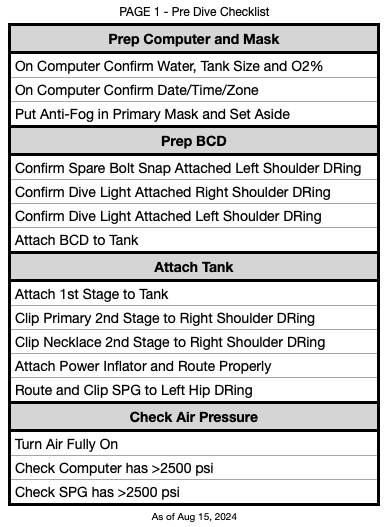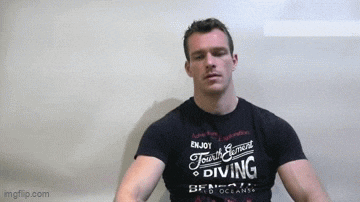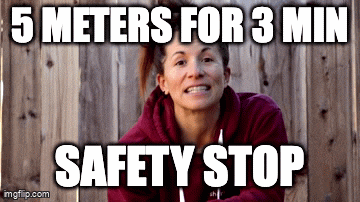 Gear Setup and Check
Gear Setup and CheckIt is totally normal to be nervous the first time you are setting up your gear without an instructor standing over you. There is no shame in using a written checklist. If you want something less comprehensive to work from try:
Step 1: Put BCD on tank
Step 2: Put regulator on tank and open valve fully (no quarter turn back shenanigans)
Step 3: Breath off primary regulator and secondary regulator to confirm they work
Step 4: Clip SPG to BCD and visually confirm PSI is what you expect
Step 5: Put weights in the various pockets
Step 6: Lay tank/bcd down so it doesn't tip over
Step 7: Get into your wetsuit
Step 8: Wait for your buddy to get ready
 Common Issues During Gear Setup
Common Issues During Gear Setup- Attaching the regulator to the tank before the BCD - solve this by always starting with the BCD
- BCD is too low or two high on the tank - If you don't know what is best for you, then place the top of the BCD in line with the top of the tank (red line in image)
- Tank valve pointed in the wrong direction - solve this by placing the tank in front of you and making sure the valve is facing towards you
- Trying to put the 1st stage on backwards - solve this by making sure the 1st stage is between you and the tank valve
- A free flow of one of the regulators when you turn on the tank valve - solve this by turning the tank valve on sloooooooowly
- Your tank falls over - NEVER WALK AWAY FROM A TANK THAT IS STANDING UP AND UNSECURED...not even for a second...lay it down
- I've never been here before - what should we do on our dive?
- Would you mind if you lead and I followed?
- What will be our maximum depth you think? (it would be a poor risk decision to go beyond 60ft on your first few non-training dives)
- I'd like to begin our ascent when we get to 1,000 PSI...are you okay with that? (assuming you have not made a poor risk decision of diving in an overhead environment)
- Are you ready?.....Yes I am ready
- [Ok hand signal] (usually means are you ready?)...[Ok hand signal back]...(Yes I am ready)
- [Regulator in mouth and thumb pointing down] (ready to begin the dive/descend?)....[regulator in mouth and thumb pointing down] (yes I'm ready to dive/descend)
- When you begin your descent and are dumping air from your BCD...you are not holding the deflator down for several feet under the water. - if you have a lot of air remaining in your BCD as you descend you are generally over weighted
- When you begin your descent you do not have to swim down or be pulled down - duck diving or swimming down would generally indicate under weighting
- As you approach the depth you want to stay at you need to add only a couple quick puffs of air to your BCD to stop your descent - if you need to mash your BCD inflator or constantly adding air as you descend to slow yourself down you are generally over weighted
- During your ascent, as you reach 15ft, you are only dumping small amounts of air from your BCD to stop your ascent - if you have to hold your deflate button down and streams of bubbles are coming out, you are generally over weighted
- During your ascent, as you reach 15ft, there is no more air left in your BCD to vent - you are generally under weighted
- Ascend at a rate no greater than 10ft per minute - so your body has ample time to decompress
- Take a "safety stop" at 15-20ft for 3 minutes - so your body has ample time to decompress
- Called Dive #1: Had planned to do a two tank dive at Three Oaks Rec and after the first dive I just didn't feel "right" and told my buddy I was done for the day.
- Called Dive #2: Had planned to do a two tank dive at Pearl Lake and my buddy was diving doubles with an extra AL80 slung so the plan was for me to get out of the water while he stayed in (we were in a group so don't get your knickers in a knot) and I would swap my tanks and rejoin him so he could get a super long single dive. We got to my turn pressure and I signaled that I was calling the dive.
- Called Dive #3: I woke up and thought maybe I was about to get a cold as my nose and ears just felt off. So I told my buddy I had to call the dive before we even got in the car to go to the quarry.
- Almost Called Dive #4: After 3 days of GUE Fundies I was mentally and physically exhausted and after I talked to my instructor I continued the 4th day. Everything went fine...however, I brought up the fact that my body was telling me to stop and we talked about it and she made it clear that it was my decision and she would support whatever decision I made.
Pre-Dive Briefing
It is also normal, unfortunately, for your group or buddy to not do a Pre Dive / Buddy Check that doesn't mean you shouldn't or can't ask for one. If you are too nervous to do so, also normal, then ask these basic questions of your buddy (assuming your buddy has more experience):
 Communicating with Your Buddy
Communicating with Your BuddyGenerally speaking everyone uses the same basic hand signals. However, it is very uncommon that new divers are taught all the "basic" hand signals during open water. Learn at least these. If your dive buddy has significant experience in this particular dive location, you may want to ask them are there any hand signals you should expect from them during the dive besides the normal ones.
For verbal or hand signal communication while above water, treat any questions or statements from your buddy as an attempt at confirmation and give the identical signal back (assuming it's correct).
For example:
Entering the Water
You are likely going to enter the water one of two ways... If possible...do a shore entry at a pond/lake/quarry for your first few dives after training. More things can go wrong stepping off a boat into the deep blue than kneeling in 2 feet of water and you want to get comfortable with entering the water with the least amount of stress as possible.
You are likely going to enter the water one of two ways... If possible...do a shore entry at a pond/lake/quarry for your first few dives after training. More things can go wrong stepping off a boat into the deep blue than kneeling in 2 feet of water and you want to get comfortable with entering the water with the least amount of stress as possible.
Step 9: Confirm the tank valve is still open
Step 10: Put on your BCD
Step 11: Partially inflate your BCD
Step 12: Put the regulators where you want them
Step 13: Put the mask on your head
Step 14: Grab your fins
Step 15: Follow your buddy into waist deep water
Step 16: Kneel/squat/whatever and put on your fins
Step 17: Ask your buddy to check your tank valve and that your equipment looks squared away / correct - Maybe even do a Bubble Check
Step 18: Tell your buddy you are ready
If you are wearing a wetsuit, don't forget to "flush" the wetsuit. What that means is to put your finger into the kneck seal and let some water in. Yes it will be chilly. It removes air from your wetsuit that is making you extra buoyant and will mess with your bouyancy during the dive if you don't, particulary descending.
As you descend, equalize your ears early and often. You can't do it too much.
It is not uncommon to feel like your mask is squeezing onto your face as you descend. That's called "mask squeeze". You can either blow out of your nose a little bit or use your mask clearing skill to hold your mask in place and break the bottom seal of the mask and blow out your nose.
Maintaining Buoyancy
For ALL...yes ALL new divers their buoyancy control and trim sucks. It's a fact of life, we all remember our first dives. Don't worry about it. When an experienced diver is your buddy they expect it. It's okay.
If during your training dives you never did a Proper Weight Check then tell your buddy you want to do one at the end of the dive. Most divers I've come across think that shows maturity and an interest in being better and they will totally be willing to help with that.
It is hard to generalize what it should feel like when your buoyancy is correct, but here are some potential indicators:
As you can hopefully see from the above, proper weighting is a delicate balance. And since the majority of your weight and buoyancy is your body that is a giant bag of water, it can be difficult. It's a goldilocks principle of you want to be "just right". It could take several dives to get your weight dialed in. After 50 dives I thought I had my weight dialed in and then I took the GUE Fundies class and found out I could actually remove 30% more weight. Who knew!
Ascending and Safety Stop
 EVERY dive involves decompression when you return to the surface. You should have learned during your Open Water class about "No Decompression Limits" (NDLs) or "Non Stop" dives. That is a nominclature to indicate that you do not have an OBLIGATION to make a decompression stop.
EVERY dive involves decompression when you return to the surface. You should have learned during your Open Water class about "No Decompression Limits" (NDLs) or "Non Stop" dives. That is a nominclature to indicate that you do not have an OBLIGATION to make a decompression stop. However, regardless of the depth, it is highly recommended you do one of two things:
Listen to Your Body
Some days...your body just doesn't want to go diving. In my first 50 dives I called 3 dives and thought about calling 1 other one because my mind and body just wasn't in it. Remember the safety rule that ANYONE can call ANY dive for ANY reason.
NOT ONCE did my dive buddy get angry or show an emotional disappointment. And they dove with me again later. If you don't have dive buddies like this...find new ones.
In 2023...I met a random person online and we went diving at Three Oaks Rec. She ended up being a dive buddy of mine for probably 10-15 dives that year while her significant other / normal dive buddy was out of town. On our first dive she told me she can sometimes have ear equalization problems on descent and apologized profusely. So what! So we descend in 2 minutes instead of 1...who cares. She is a great diver and we had a blast. She knew her body and she listened to it.
